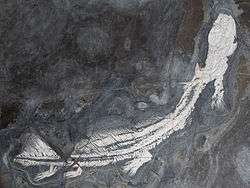Orthacanthus
| Orthacanthus Temporal range: Lower Carboniferous - Permian | |
|---|---|
 | |
| Fossil in Vienna | |
| Scientific classification | |
| Kingdom: | Animalia |
| Phylum: | Chordata |
| Class: | Chondrichthyes |
| Subclass: | Elasmobranchii |
| Superorder: | Euselachii |
| Order: | Xenacanthida |
| Family: | Orthacanthidae |
| Genus: | Orthacanthus Agassiz, 1843 |
| Species | |
| |

Orthacanthus is an extinct genus of fresh-water shark from a family of prehistoric sharks known as xenacanths. Members of the genus had a long spine growing from the back of their skull and a very long dorsal fin, which ran all along its back giving it an eel-like appearance.[1]
About 260 million years ago, Orthacanthus was the apex predator of freshwater swamps and bayous in Europe and North America. Its body reached nearly 10 feet (3 meters) in length and the shark possessed a peculiar set of double-fanged teeth. They first appeared about 400 million years ago in the Devonian, and became extinct just before the Mesozoic, about 225 million years ago.
Cannibalism
Examination of Othacanthus coprolites from Canada by Aodhan O' Gogain et al revealed that in times of hardship, Orthacanthus was likely cannibalistic, as teeth from juvenile Orthacanthus were found within the coprolites of adults.[2][3]
References
- ↑ Gogáin, Aodhán Ó; Falcon-Lang, Howard J.; Carpenter, David K.; Miller, Randall F.; Benton, Michael J.; Pufahl, Peir K.; Ruta, Marcello; Davies, Thomas G.; Hinds, Steven J.; Stimson, Matthew R. (11 August 2016). "Data from: Fish and tetrapod communities across a marine to brackish salinity gradient in the Pennsylvanian (early Moscovian) Minto Formation of New Brunswick, Canada, and their palaeoecological and palaeogeographical implications". Palaeontology. ISSN 1475-4983.
- ↑ http://www.businessinsider.com/ancient-sharks-were-cannibals-2016-8
- ↑ http://www.eurekalert.org/pub_releases/2016-08/tcd-utc081016.php
| Wikimedia Commons has media related to Orthacanthus. |
